Navajo Sandcast Pin - Pendant with Handmade Chain - C3777N
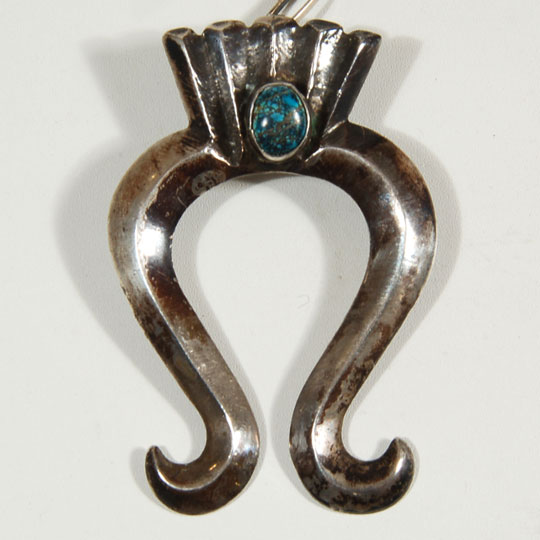 Sandcast silver jewelry is recognized as a distinctly traditional Navajo technique. To make sandcast pieces, molten silver is poured into a mold. The mold is good for only one item. It is a complicated process, with every piece unique.
Sandcast silver jewelry is recognized as a distinctly traditional Navajo technique. To make sandcast pieces, molten silver is poured into a mold. The mold is good for only one item. It is a complicated process, with every piece unique.
Three Navajo Sterling Silver Stamped Converted Moccasin Buttons - C3777i
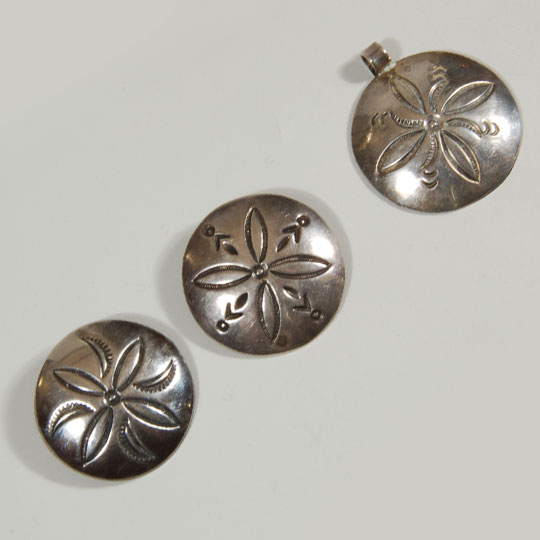 Among the first objects of adornment created by Navajo silversmiths in the mid-19thcentury were buttons and collar decorations attached to clothing. It was a way of displaying and protecting one's wealth. One either wore jewelry or took it to the trading post for safe keeping as pawn jewelry.
Among the first objects of adornment created by Navajo silversmiths in the mid-19thcentury were buttons and collar decorations attached to clothing. It was a way of displaying and protecting one's wealth. One either wore jewelry or took it to the trading post for safe keeping as pawn jewelry.
Historic Child Size Kewa (Santo Domingo) Pueblo Jar - C3783D
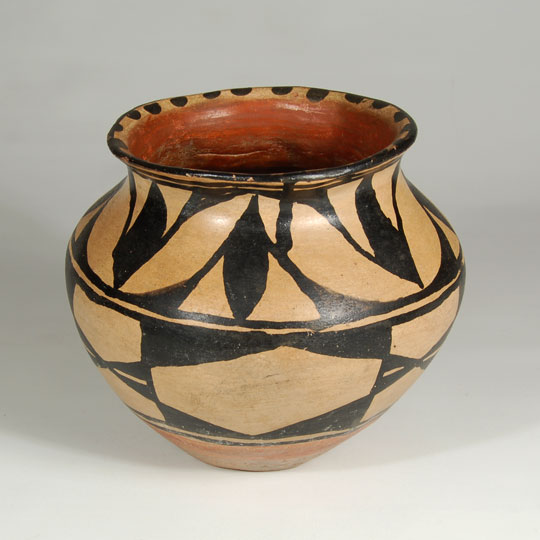 The designation "child's size jar" is not meant to demean the item but to more or less describe its size. It does not indicate that the jar was made by a child but perhaps was made as a training aid for a young female to use in practicing walking with the jar on her head, with or without water. Jars of this size also were made for storage of personal items and for sale to tourists. There could be many reasons for such a jar.
The designation "child's size jar" is not meant to demean the item but to more or less describe its size. It does not indicate that the jar was made by a child but perhaps was made as a training aid for a young female to use in practicing walking with the jar on her head, with or without water. Jars of this size also were made for storage of personal items and for sale to tourists. There could be many reasons for such a jar.
This jar is very typical of those made at Santo Domingo Pueblo in the first quarter of the 20th century when tourists were visiting the pueblo and the trading post that was located adjacent to the rail tracks. The daily traffic at Santo Domingo Trading Post necessitated many items of pottery, jewelry and curio items to satisfy the demand of many visitors. Jars of this size certainly would have been popular because of their convenience for easy transportation.
Zuni Pueblo Polychrome Historic Dough Bowl - C3783C
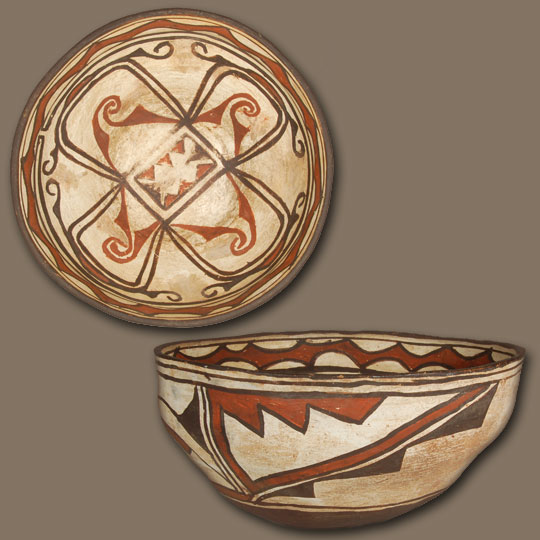 It would be interesting to share with you a little about the history involving Zuni Pueblo before giving details about this dough bowl. The Bureau of Ethnology (BAE) was created by an act of Congress in 1879 and put under the control of the Smithsonian Institution, with John Wesley Powell as its first director. He wasted no time in setting up his plans for the BAE. Within a few months, he sent an expedition to visit Zuni Pueblo to collect material from and information about the Zuni culture.
It would be interesting to share with you a little about the history involving Zuni Pueblo before giving details about this dough bowl. The Bureau of Ethnology (BAE) was created by an act of Congress in 1879 and put under the control of the Smithsonian Institution, with John Wesley Powell as its first director. He wasted no time in setting up his plans for the BAE. Within a few months, he sent an expedition to visit Zuni Pueblo to collect material from and information about the Zuni culture.
Colonel James Stevenson and his wife, Matilda Coxe Stevenson, departed for Zuni on August 1, 1879 also to collect for the BAE. John K. Hillers, photographer, and Frank Hamilton Cushing, ethnology assistant at the Smithsonian, accompanied the Stevensons.
Abstract Eagle and Rainbow Painting by Anselmo Martinez - C3789G
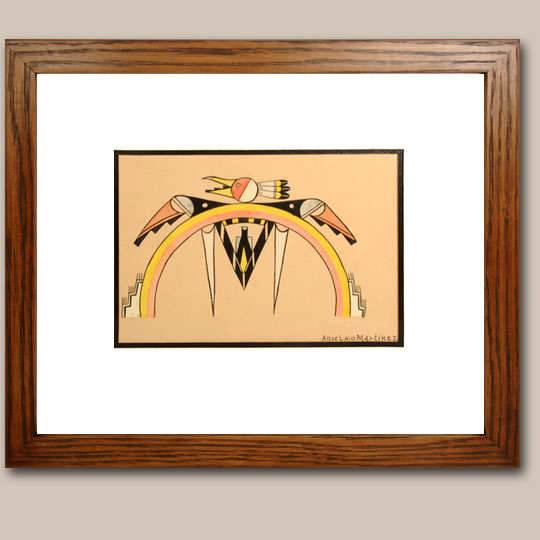 Occasionally a painting arrives at the gallery by an artist from whom we have never seen one before, and for which there is no published information in the standard reference books on Native artists. Anselmo Martinez was the son of Louis Martinez, the brother of Julian Martinez. He was married to Lupita Martinez, a potter. We found a reference to him because of his relation to Julian.
Occasionally a painting arrives at the gallery by an artist from whom we have never seen one before, and for which there is no published information in the standard reference books on Native artists. Anselmo Martinez was the son of Louis Martinez, the brother of Julian Martinez. He was married to Lupita Martinez, a potter. We found a reference to him because of his relation to Julian.
Hopi Pueblo Cottonwood Umtoinaqa (Thunder) Katsina Doll - C3784E
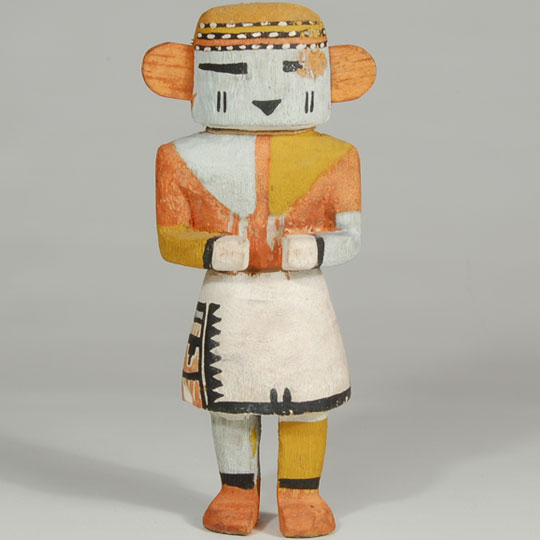 According to published information by Barton Wright "Umtoinaqa is the Shooting Thunder Kachina. He acts as a policeman or guard during the Bean Dance but is most commonly seen in the Mixed Katsina Dances. The bull roarer that he carries in his hand is used to imitate the sound of thunder."
According to published information by Barton Wright "Umtoinaqa is the Shooting Thunder Kachina. He acts as a policeman or guard during the Bean Dance but is most commonly seen in the Mixed Katsina Dances. The bull roarer that he carries in his hand is used to imitate the sound of thunder."
Large Santa Clara Pueblo Polychrome Jar signed Lela/Van - 25861
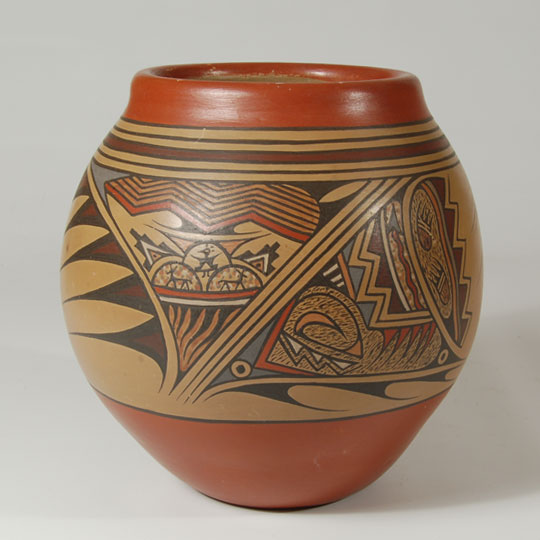 Lela Naranjo Gutierrez (1895-1966) and her husband Van (c1870-1956) tested many ideas in pottery making, but only after developing a decorative scheme featuring earth colors on a matte background did they achieve enduring success. Bold curvilinear designs on neutral tan or beige became the base for a new Santa Clara style.
Lela Naranjo Gutierrez (1895-1966) and her husband Van (c1870-1956) tested many ideas in pottery making, but only after developing a decorative scheme featuring earth colors on a matte background did they achieve enduring success. Bold curvilinear designs on neutral tan or beige became the base for a new Santa Clara style.
The polychrome wares created by Lela and Van continued to be produced by younger members of the Gutierrez family, notably their children Margaret and Luther, and Luther's daughter Pauline. Following the death of his dad, Luther teamed with his mom and the two worked until Lela passed away, then Luther and his sister Margaret teamed until Luther passed away. Now Margaret works alone.
Nineteenth Century Zuni Pueblo Polychrome Jar - C3776B
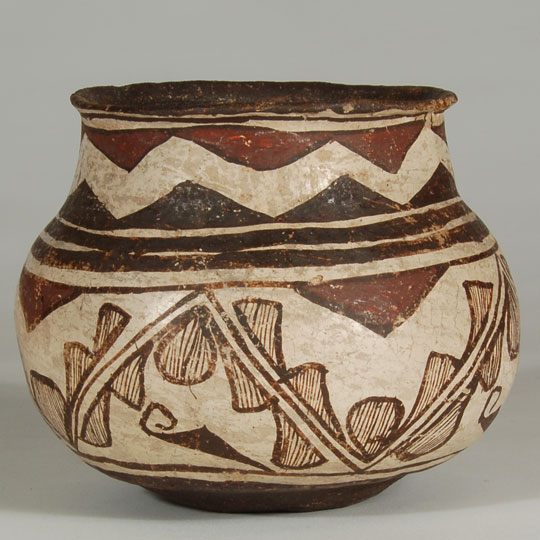 This excellent small Zuni Polychrome jar dates to the last quarter of the 19th century. It is of a size for which it is difficult to ascribe a function. Vessels of this size could have been made for repositories of sacred cornmeal, for a gift to a newborn child, or even as a training piece for a beginning potter. It is truly rare to find such an exquisite jar of this diminutive size and of such extraordinary beauty and condition.
This excellent small Zuni Polychrome jar dates to the last quarter of the 19th century. It is of a size for which it is difficult to ascribe a function. Vessels of this size could have been made for repositories of sacred cornmeal, for a gift to a newborn child, or even as a training piece for a beginning potter. It is truly rare to find such an exquisite jar of this diminutive size and of such extraordinary beauty and condition.
It is undeniably Zuni in form, design, materials and character, and is an intriguing and atypical example of late Zuni artistry. The paste is typically Zuni, gray in color with a chunky texture, the temper being ground pottery shards. The underbody and neck interior are black, with white stone-polished slip on the exterior body.
Navajo Ingot Silver and Turquoise Bracelet - 25860
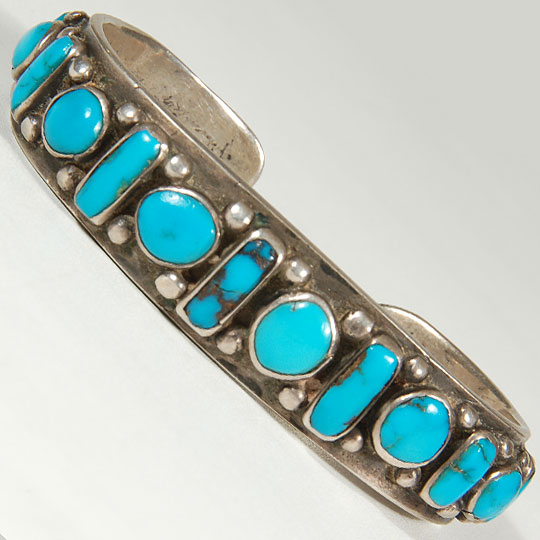 Before sheet silver became the source material for silversmiths, there existed ingot silver and, before that, coin silver. Ingot silver was popular in the early 20th century up to the middle of the century. This Navajo bracelet was fashioned from ingot silver and is quite sturdy and heavy. An enormous amount of turquoise was placed on the bracelet covering the entire top surface and extending around to the sides. There are 13 beautiful blue cabs, each set in a silver bezel and each setting separated by pairs of silver dots. Simple stamping was placed on each end of the bracelet. It is quite possible that this jewelry bracelet dates to circa 1920s.
Before sheet silver became the source material for silversmiths, there existed ingot silver and, before that, coin silver. Ingot silver was popular in the early 20th century up to the middle of the century. This Navajo bracelet was fashioned from ingot silver and is quite sturdy and heavy. An enormous amount of turquoise was placed on the bracelet covering the entire top surface and extending around to the sides. There are 13 beautiful blue cabs, each set in a silver bezel and each setting separated by pairs of silver dots. Simple stamping was placed on each end of the bracelet. It is quite possible that this jewelry bracelet dates to circa 1920s.
Kewa Pueblo Turquoise Nugget Necklace with Jaclas - 25859
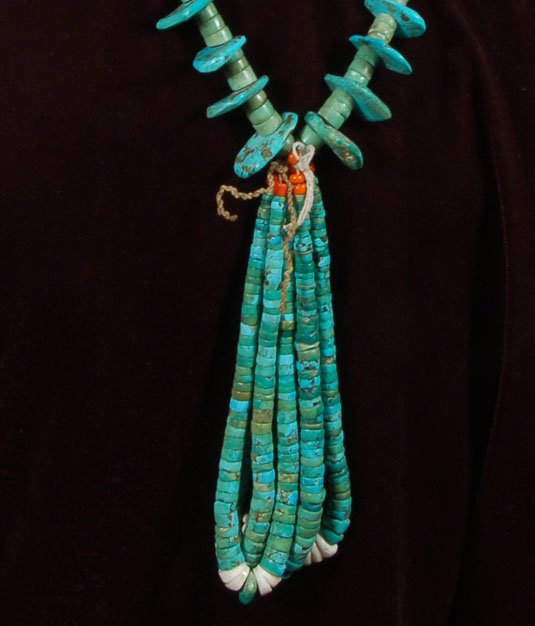 The Anasazi are the ancient ones, the ones who preceded the contemporary pueblo peoples. At an Anasazi ruin in Utah in 1960, archaeologists unearthed a buried female who had passed away around 1100. Around the neck of the remains was a beautiful turquoise necklace. Necklaces such as this are still the most favored among the Pueblo people of today.
The Anasazi are the ancient ones, the ones who preceded the contemporary pueblo peoples. At an Anasazi ruin in Utah in 1960, archaeologists unearthed a buried female who had passed away around 1100. Around the neck of the remains was a beautiful turquoise necklace. Necklaces such as this are still the most favored among the Pueblo people of today.
From the earliest of times, turquoise has been favored by the Pueblo Indians of the Southwest. They mined it at Cerrillos, about 30 miles south of Santa Fe, for centuries. Turquoise had religious, ceremonial, superstitious and economic values to the Pueblo Indians.
Acoma Pueblo Twentieth Century Water Jar by Mary Histia - C3785B
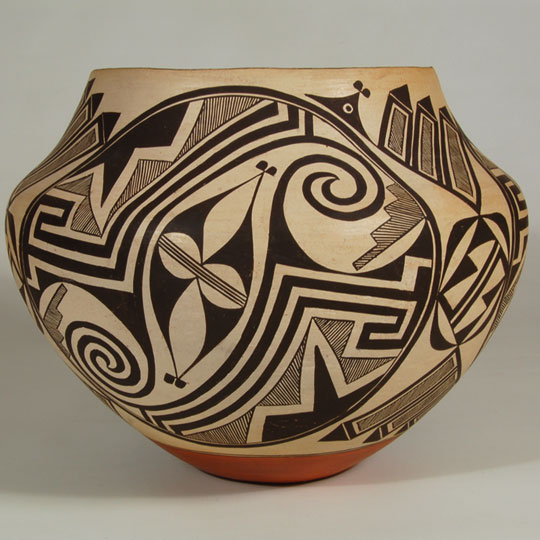 This is a strikingly beautiful Acoma Pueblo polychrome water jar with a high shoulder decorated in black-on-white designs and devoid of red except for the underbody. The intricate Tularosa-style design is a series of curvilinear, rectilinear, and fine-line elements combined in an Escher-like manner that is as contemporary as any design and yet reflects its roots of a thousand years ago.
This is a strikingly beautiful Acoma Pueblo polychrome water jar with a high shoulder decorated in black-on-white designs and devoid of red except for the underbody. The intricate Tularosa-style design is a series of curvilinear, rectilinear, and fine-line elements combined in an Escher-like manner that is as contemporary as any design and yet reflects its roots of a thousand years ago.
Hopi Pueblo Cottonwood Root Mudhead Katsina Doll - C3784B
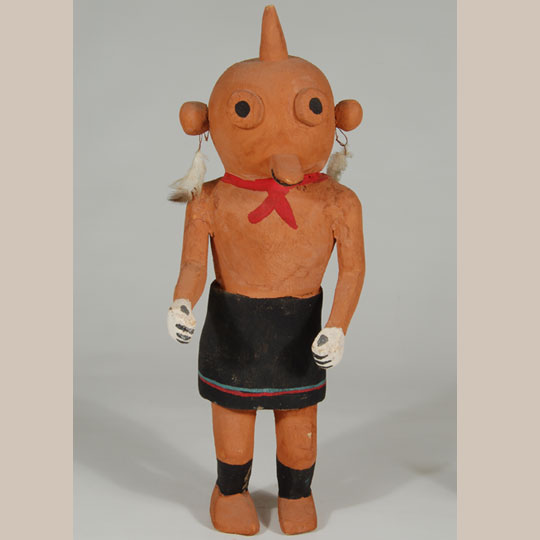 It is not unusual for this doll to be called a "Mudhead Katsina" or a "Koyemsi" as those are names that have been used for a hundred years or more. Barton Wright states that it is not considered a katsina at Hopi and that Mudhead and Koyemsi are both nicknames. Wright states that Tachukti is the correct name, Tachukti being the name of a clown, however, Wright says that they are not clowns in the sense we normally consider a clown. It will, however, always be called a Mudhead as that name is not likely to go away.
It is not unusual for this doll to be called a "Mudhead Katsina" or a "Koyemsi" as those are names that have been used for a hundred years or more. Barton Wright states that it is not considered a katsina at Hopi and that Mudhead and Koyemsi are both nicknames. Wright states that Tachukti is the correct name, Tachukti being the name of a clown, however, Wright says that they are not clowns in the sense we normally consider a clown. It will, however, always be called a Mudhead as that name is not likely to go away.
Original Painting of a Full-Figure Yei by Tony Abeyta - 25858
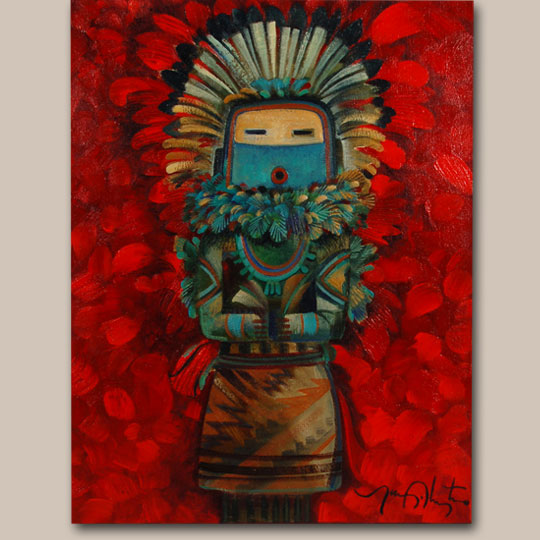 The Yei (pronounced yay) are the supernatural beings of the Diné. They are often pictured today in Navajo textiles and fine art, but their original, and still current, presentation was in ceremonial healing sandpaintings. Once the taboo was broken in the early 20th century of presenting healing sandpaintings only in non-permanent form, other uses of the Yei figures developed. Ceremonial healing sandpaintings must be destroyed after use and there was a time when this was the only manner in which the Yei figure was seen. After the Yei was presented in woven textile form in the early 20th century, its use became more common in items such as permanent sandpaintings made to sell to tourists. Today, there are no restrictions against presenting the Yei in art form.
The Yei (pronounced yay) are the supernatural beings of the Diné. They are often pictured today in Navajo textiles and fine art, but their original, and still current, presentation was in ceremonial healing sandpaintings. Once the taboo was broken in the early 20th century of presenting healing sandpaintings only in non-permanent form, other uses of the Yei figures developed. Ceremonial healing sandpaintings must be destroyed after use and there was a time when this was the only manner in which the Yei figure was seen. After the Yei was presented in woven textile form in the early 20th century, its use became more common in items such as permanent sandpaintings made to sell to tourists. Today, there are no restrictions against presenting the Yei in art form.
Hopi Pueblo Tsu’katsina (Snake) Doll - C3783H
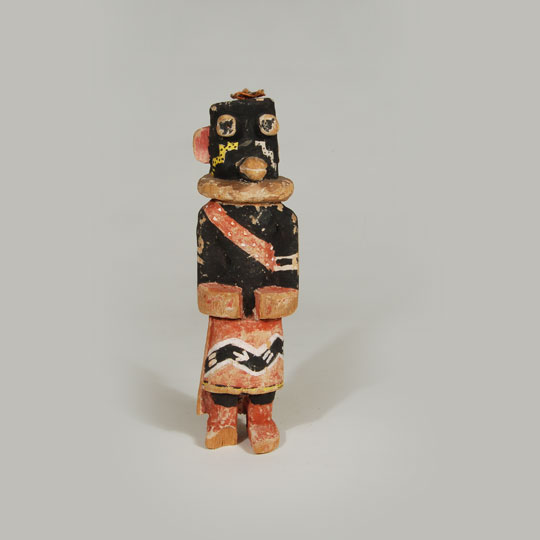 Positive identification of the katsina that this doll represents is not known. I have been told that he has been referred to as Tsu'katsina, meaning a Snake Katsina, but that is not necessarily the actual Hopi name. For now, that is the name we will use.
Positive identification of the katsina that this doll represents is not known. I have been told that he has been referred to as Tsu'katsina, meaning a Snake Katsina, but that is not necessarily the actual Hopi name. For now, that is the name we will use.
Historic Kewa - Santo Domingo Pueblo Jar - C3753.63
 During the period 1920 to 1940, many potters at Santo Domingo were hastily making tourist wares to be sold by the roadside, but later in the period, there was an improvement in the quality of the tourist wares. It was also at this time that designs began to include birds, plant forms, and animals, with accents in red, much more than ever before. The potential for sales seemed to be greater when these design elements were used. This jar dates to circa 1930.
During the period 1920 to 1940, many potters at Santo Domingo were hastily making tourist wares to be sold by the roadside, but later in the period, there was an improvement in the quality of the tourist wares. It was also at this time that designs began to include birds, plant forms, and animals, with accents in red, much more than ever before. The potential for sales seemed to be greater when these design elements were used. This jar dates to circa 1930.
Painting of a Young Navajo Girl and her Lamb by Santa Fe Artist Vladan Stiha - C3787
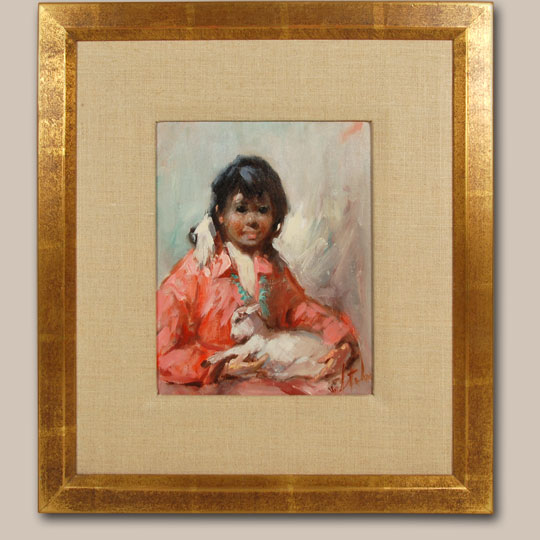 A life of patience and fortitude paid off for Vladan Stiha. He had been born in Yugoslavia and departed his home country when it was invaded during World War II. He attempted to immigrate to the United States but the quota was full so he went to Buenos Aires, Argentina, and ten years later, moved to Sao Paula, Brazil. It was during the twenty years he spent in South America that he developed his impressionistic style and use of vivid colors-rich colors based on those so visible in the landscapes and clothing of the colorful peasants he witnessed.
A life of patience and fortitude paid off for Vladan Stiha. He had been born in Yugoslavia and departed his home country when it was invaded during World War II. He attempted to immigrate to the United States but the quota was full so he went to Buenos Aires, Argentina, and ten years later, moved to Sao Paula, Brazil. It was during the twenty years he spent in South America that he developed his impressionistic style and use of vivid colors-rich colors based on those so visible in the landscapes and clothing of the colorful peasants he witnessed.
Historic Bulbous Water Canteen from Acoma Pueblo - C3785C
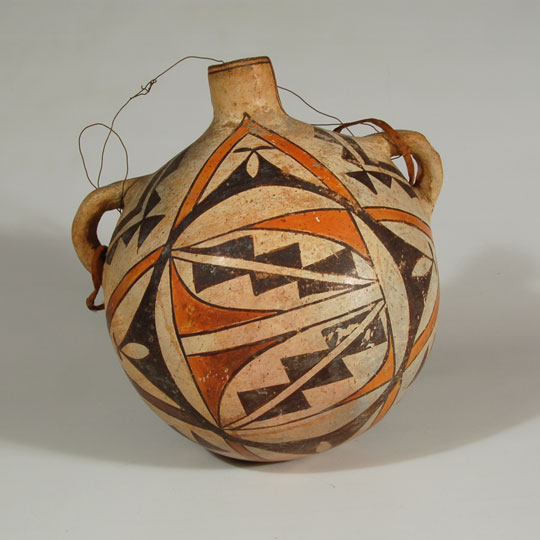 Traditionally, canteens were made at the pueblos for the men to fill with water and take to the fields with them. Of course, collectors sought after them as well, so potters began making them to sell. This one from Acoma is particularly well made. It has a bulbous shape reminiscent of prehistoric canteen shapes. It is larger than most that were made for sale to tourists so it probably was made for pueblo use, until, that is, when a hole got punctured into the body. At that point, it became available for purchase.
Traditionally, canteens were made at the pueblos for the men to fill with water and take to the fields with them. Of course, collectors sought after them as well, so potters began making them to sell. This one from Acoma is particularly well made. It has a bulbous shape reminiscent of prehistoric canteen shapes. It is larger than most that were made for sale to tourists so it probably was made for pueblo use, until, that is, when a hole got punctured into the body. At that point, it became available for purchase.
Tall and Graceful Wedding Vessel from Acoma Pueblo by Helen R. Vallo - C3785A
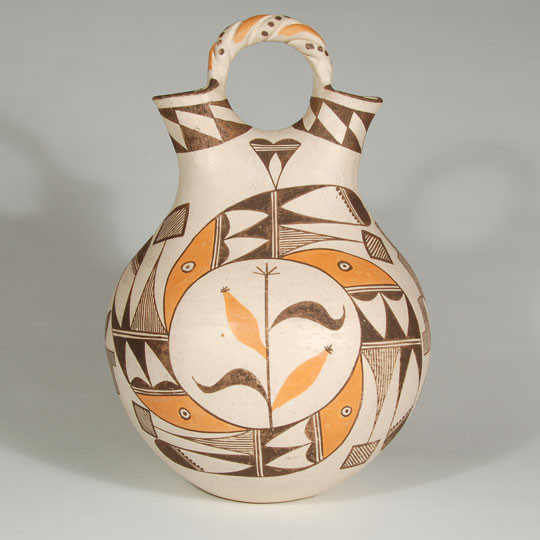 We have been posting items from the former trading post in Carlsbad, New Mexico that closed in 1977 known as Chief Sunny Skies Trading Post. This wedding vessel is another item related to that family. It was made by Helen Vallo of Acoma Pueblo and she was a cousin to Chief Sunny Skies (Clyde Hunt) and the mother of Henry Vallo. The family had retained all the inventory remaining from the trading post since 1977 and has been releasing it to us over the past year. Here is another great item that stayed in the family and is still owned by Helen's son, Henry Vallo.
We have been posting items from the former trading post in Carlsbad, New Mexico that closed in 1977 known as Chief Sunny Skies Trading Post. This wedding vessel is another item related to that family. It was made by Helen Vallo of Acoma Pueblo and she was a cousin to Chief Sunny Skies (Clyde Hunt) and the mother of Henry Vallo. The family had retained all the inventory remaining from the trading post since 1977 and has been releasing it to us over the past year. Here is another great item that stayed in the family and is still owned by Helen's son, Henry Vallo.
Very Early Hopi Pueblo Sootukwnug'taqa Katsina Doll - C3783i
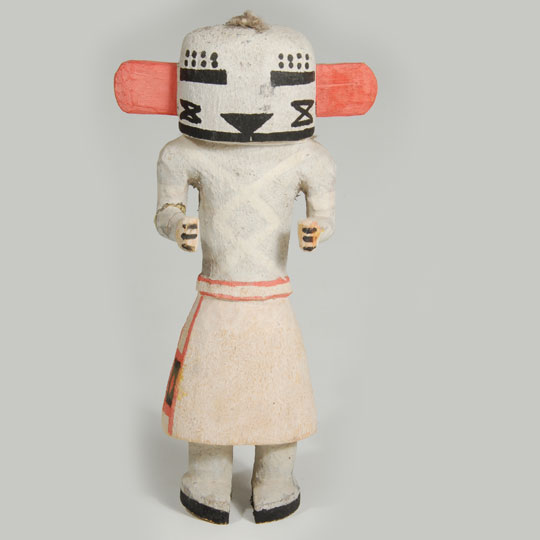 This was a difficult katsina on which to find published data because I did not recognize it. I had to consult with my trusted katsina expert to figure out which katsina this doll represented. He immediately identified it asSootukwung'taqa and said that it was missing the crown, a protrusion pointing up from the top of the head. He is also missing the lightning bolt and bull roarer he uses to make thundering sounds.
This was a difficult katsina on which to find published data because I did not recognize it. I had to consult with my trusted katsina expert to figure out which katsina this doll represented. He immediately identified it asSootukwung'taqa and said that it was missing the crown, a protrusion pointing up from the top of the head. He is also missing the lightning bolt and bull roarer he uses to make thundering sounds.
Beautiful Historic Polychrome Water Jar from Laguna Pueblo - C3783B
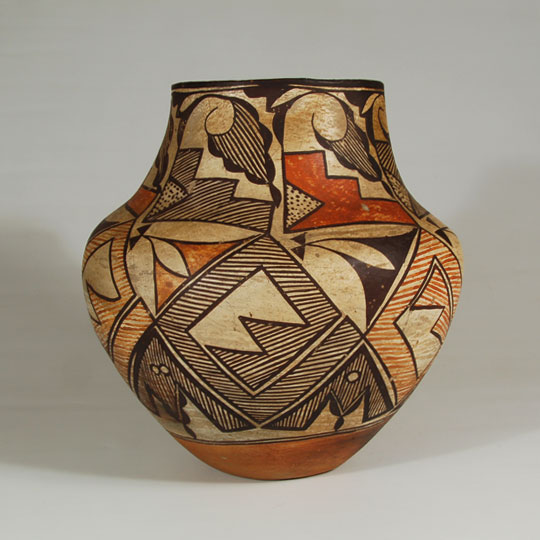 Refugees from Acoma, Zuni and other pueblos established Laguna Pueblo a few years after the Pueblo Revolt of 1680. Its date of establishment was 1699. As a result, its pottery can be very similar to that of Acoma and Zuni Pueblos, and, for the most part, is indistinguishable from ceramics at Acoma, but not so much from that at Zuni except for similarity in design elements. Acoma and Laguna clay is similar but Zuni clay differs from that at those two pueblos. Sometimes designs must be used as a guideline for distinguishing ceramics at Laguna.
Refugees from Acoma, Zuni and other pueblos established Laguna Pueblo a few years after the Pueblo Revolt of 1680. Its date of establishment was 1699. As a result, its pottery can be very similar to that of Acoma and Zuni Pueblos, and, for the most part, is indistinguishable from ceramics at Acoma, but not so much from that at Zuni except for similarity in design elements. Acoma and Laguna clay is similar but Zuni clay differs from that at those two pueblos. Sometimes designs must be used as a guideline for distinguishing ceramics at Laguna.

